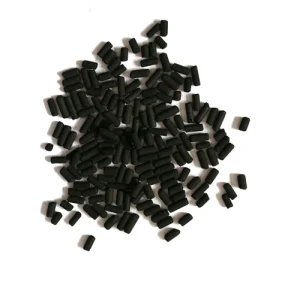

Extruded activated carbon (EAC)
Consists of extruded and cylindrical shaped activated carbon with diameters from 0.8 to 45 mm. These are mainly used for gas phase applications because of their low pressure drop, high mechanical strength and low dust content.
Production
Activated carbon is produced from carbonaceous source materials like nut shell,coconut shells, wood, and coal. It can be produced by one of the following processes:
Physical reactivation: The precursor is developed into activated carbons using gases. This is generally done by using one of or combining the following processes:
Carbonization: Material with carbon content is pyrolysed at temperatures in the range 600-900 °C, in absence of air (usually in inert atmosphere with gases like argon or nitrogen)
Activation/Oxidation: Raw material or carbonised material is exposed to oxidizing atmospheres (carbon dioxide, oxygen, or steam) at temperatures above 250 °C, usually in the temperature range of 600-1200 °C.
Chemical activation: Impregnation with chemicals such as acids like phosphoric acid or bases like potassium hydroxide, sodium hydroxide or salts like zinc chloride, followed by carbonization at temperatures in the range of 450-900 °C. It is believed that the carbonization / activation step proceeds simultaneously with the chemical activation. This technique can be problematic in some cases, because, for example, zinc trace residues may remain in the end product. However, chemical activation is preferred over physical activation owing to the lower temperatures and shorter time needed for activating material.
| Analysis | Index | Analysis | Index |
| Iodine Value | 500-1100mg/g | Filling density | 0.38-0.55g/cm3 |
| Surface Area | >1000m²/g | Strength | 92%min |
| Total pore volume | 0.9cm3/g | Moisture | 8% or less |
| CTC | 50%-85% | PH value | 5-9 |
| Ash content | <5% | Fire point | 500°C |